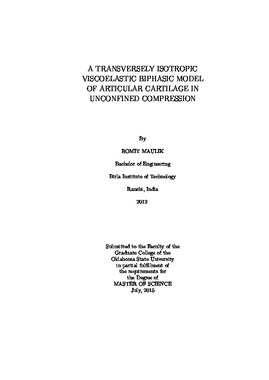| dc.contributor.advisor | Hatami-Marbini, Hamed | |
| dc.contributor.author | Maulik, Romit | |
| dc.date.accessioned | 2018-04-24T13:02:25Z | |
| dc.date.available | 2018-04-24T13:02:25Z | |
| dc.date.issued | 2015/7/1 | |
| dc.identifier.uri | https://hdl.handle.net/11244/299667 | |
| dc.description.abstract | Articular cartilage is a connective tissue found in diarthrodial joints such as the knee, elbow or wrist. It is composed of collagen fibers, chondrocytes, interstitial fluid, and other non-collagenous proteins. During locomotion, the articular cartilage of the knee is primarily subjected to compressive stress caused by the upper body weight of the host. It is of great interest to investigate the mechanical behavior of this specialized connective tissue in compression and understand its ability to withstand high stresses without any damage. In recent years, unconfined compression experiments and biphasic numerical models have been widely used for this purpose.The primary goal of this thesis was to develop an improved biphasic constitutive model for the mechanical behavior of cartilage in unconfined compression. For this purpose, the tissue was assumed to be composed of a transversely isotropic viscoelastic solid phase and an incompressible fluid phase. Using this premise, along with the classical biphasic material model assumptions, it was shown that the governing equilibrium equations can be simplified to two partial differential equations for the radial displacement of the solid phase and the pressure of the fluid phase. These coupled differential equations were solved and a numerical solution for the axial load intensity was obtained. The results of this computational model were then used to analyze previous experimental studies on articular cartilage. To this end, an optimization algorithm was used to conduct a non-linear least squares regression analysis and find the material parameters of the proposed model. It was observed that the proposed model could successfully predict the mechanical response of the tissue in high strain rate compression experiments with much greater accuracy as compared to most of the currently existing models in literature. For low strain rate compression experiments, although the model was able to represent the stress-relaxation behavior fairly accurately, higher residuals were obtained. This suggests that the solid phase viscoelasticity may play an important role in the overall stress relaxation mechanism of the tissue at high compressive strain rates. In conclusion, this research study provided a new analytic tool to investigate the mechanical stresses generated in an articular cartilage sample during unconfined compression. | |
| dc.format | application/pdf | |
| dc.language | en_US | |
| dc.rights | Copyright is held by the author who has granted the Oklahoma State University Library the non-exclusive right to share this material in its institutional repository. Contact Digital Library Services at lib-dls@okstate.edu or 405-744-9161 for the permission policy on the use, reproduction or distribution of this material. | |
| dc.title | Transversely Isotropic Viscoelastic Biphasic Model of Articular Cartilage in Unconfined Compression | |
| dc.contributor.committeeMember | Harimkar, Sandip P. | |
| dc.contributor.committeeMember | Rhinehart, Russell R. | |
| osu.filename | Maulik_okstate_0664M_14186.pdf | |
| osu.accesstype | Open Access | |
| dc.description.department | Mechanical & Aerospace Engineering | |
| dc.type.genre | Thesis | |
| dc.type.material | text | |
